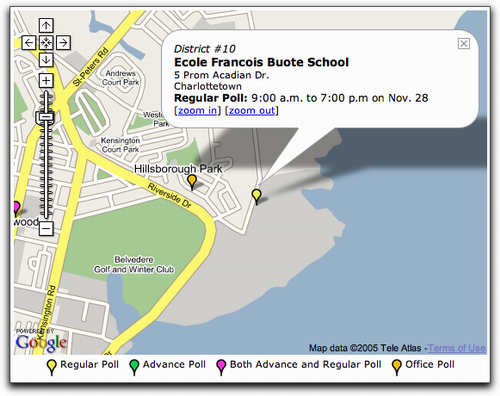Oliver and I stopped in at the “pharmacy formerly known as Pharmasave” in the Ellis Brothers Shopping Centre this afternoon only to find it re-branded at “Lawton’s.”
What’s more, our friendly Lawton’s cashier told us that with the rebranding comes a move to the old Home Hardware premises on the other side of the mall. The new store, she told us, will be much, much bigger, and will include non-pharmacy items like food and an expanded makeup section. Sounds like a run for the “everything you want in a drugstore” crowd that Shopper’s Drug mart so effectively consumes.
Speaking of Lawton’s: did you know that it’s a subsidiary of Sobeys? I didn’t.
And speaking of Island pharmacies: the big renovation at the Parkdale Pharmacy — a job that’s seems to have been going on for almost a year — looks like it’s nearing completion. As our family doctor has just moved in to the offices right next door, I suspect this cold and flu season we’ll be spending a lot of time buying Kleenex there.
And speaking of Shoppers Drug Mart, they’ve fallen down again in their Honest Tea stocking. They had a shipment it about 3 weeks ago, and I bought a good chunk of it, but they’ve been sold out for the last two weeks. I wonder why the giant glaring tea-less whole in the health foods cooler doesn’t prompt someone to make an order?
Thirteenmonths.com chronicles the journey of “a fairly normal pre-kids couple on the adventure of [their] lives.” Here’s how they describe their trip:
Instead of taking a honeymoon, we decided to fulfill a lifelong dream and travel the world for a year (13 months, actually). We started slowly saving soon after we met, and with the proper planning, it all turned out to be more affordable than we originally anticipated (let us know if you’d like more info on this). With a few exceptions, we have opted to stay in each place for about a month. We think this approach allows us time to immerse ourselves in the culture and experience how different people live. We’ve also found it to be less stressful (not to mention cheaper) than traveling constantly for a year. We hope that it also allows some of our friends and family to visit.
They left home October 5, 2004 and their last entry (at this writing) is from Brazil in June. They’re still at it, though, and they’ve got a lot of compelling tales of their adventures, including the sort of nitty gritty that’s usually left out of travelogues, like descriptions of their gear, their clothes and what it’s all costing them.
Alas, there’s no RSS feed, so you’ll have to drop by regularly if you want to keep up.
I don’t know how I missed this earlier, but the complete text of The Canadian Encyclopedia is online, thanks to the Historica Foundation. They’re the same bunch that brings us the Canadian Heritage Minutes.
Here’s the Lake Ontario article co-authored by my Dad.
I reached the zenith of my erstwhile career as a “technology commentator” in 1995. The previous summer I had produced a summer series for the local Island Morning show called “A User’s Guide to the Future.” It was all my friend Ann Thurlow’s fault. And, also, I suspect, due to Ann’s patronage, I found myself in the Morningside rolodex filed under “technology.”
And so it came to be that I found myself standing beside a van in the field outside the Robertson Library at the University of PEI one May morning in 1995. The inimitable Barry Vessey was at the controls in the van and, through the magic of radio, I was hooked up with Peter Gzowski, Kevin Kelly, and Gerri Sinclair talking about, as Gzowski put it, “a swing of the pendulum.”
We were gathered together as a part of a series called “The New World” to talk about the impact of the “new technology” on all of us.
Thanks to my father’s compulsive documentary instincts, I’ve come into possession of a recording of the panel. Oh how young I sound — almost chipmunk like; I’d like to think that is an artefact of the audio compression, but I fear I simply was that young and urgent.
My favourite part of the session comes near the end:
Me: I wonder if we should maybe just all calm down a little bit… ah, not us here specifically, but society in general…
Gzowski: Ah, the voice of Prince Edward Island… calm down!
Me: Yes, indeed… I just… I’m thinking about the fact that I’m sitting here in a field on the campus of UPEI talking into a little metal thing talking to someone in Toronto and someone in Ottawa, that seems pretty amazing to me in the greater context of technology… radio’s been around for 100, 150 years and I still think it’s amazing, and I don’t think we’ve explored the boundaries of it at all yet.
Oh to be characterized as the calming voice of Prince Edward Island. Those were the days.
There were elections in the USA yesterday — are they the “mid-mid-term” elections? And there were some important propositions on the ballot in California. As a result, a lot of people were searching Google for ‘CA Election Results’. And here’s what they saw:

Good morning Californians! Welcome to Prince Edward Island.
Prince Edward Island is holding a Plebiscite on Mixed Member Proportional Representation System on November 28, 2005.
On Plebiscite Day voters can vote at any one of the polling stations in their electoral district. This is different from a Provincial General Election, where each elector falls into a polling division and must vote at a specific poll in their district.
To aid voters in locating the polling stations (along with the advance polls, for those that need to vote early) in their district, we’ve leveraged Google Maps to create an interactive Polling Station Locations Map.
The map uses various bits of the Google Maps API to show the polling locations for each district when its name is clicked on. Clicking on any polling location shows the address and the hours for voting at that location. All the regular Google Maps functionality — zoom, pan, etc. — is available as well.

I’m becoming more and more pleasantly surprised by the versatility of the Google Maps API — it’s possible, with a little bit of PHP and a little bit of JavaScript to create extremely powerful applications, application that, in an earlier day, would have been impossible to create or taken weeks of custom coding.
Our work at Reinvented with Elections PEI and, before that, the provincial government has afforded me an intimate relationship with the province’s system of civic addressing.
In a unusual show of openness, the province makes its raw civic address data freely downloadable. You can always grab the latest copy of the 65,000 addresses in the province, along with the latitude and longitude of each one (there’s no personally identifying information in the data — it’s just street number, street name, community, county and coordinates).
As you might imagine, this is not only a Good Thing, but it has the power to enable all sorts of interesting applications based around the data.
To help push this sort of application development along, I’m releasing some open source scripts that make using the data easier.
The first of these is a PHP script that automates the process of downloading the civic address data into a MySQL database. If you’ve got access to a machine with PHP and MySQL, you can grab the script and have your own copy of the civic address database running in a few minutes.
The second script uses the excellent script.aculo.us JavaScript code to enable a PHP-based AJAX civic address lookup that looks like this:

The idea is that, like Google Suggest, as you type the address possible matches for what you’ve typed are displayed, and you can select one of these with your mouse or with arrow keys and the TAB key.
The script doesn’t actually do anything with the data once you’ve selected an address — there’s where you fill in your own magic.
Both scripts are have been only lightly tested. There’s complete information in the Rukapedia (data import \| AJAX lookup) about how to install and use them. Both are released under the GNU Public License.
Comments and suggestions welcome.
Once I started taking photos of the crane topple this afternoon, I couldn’t stop. And once I couldn’t stop, I couldn’t imagine not staying until the bitter end. Which turned out to be about four hours worth of standing out in the cold hoping that the burly Bull Dog Demolition guys wouldn’t tire of my presence and deep six me.
This result: 49 photos of the Fitzroy St. Truck Topple (or, as Steven calls it “11/6”). You can view it as a suspenseful slideshow if you like.



 I am
I am